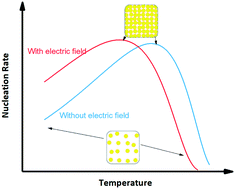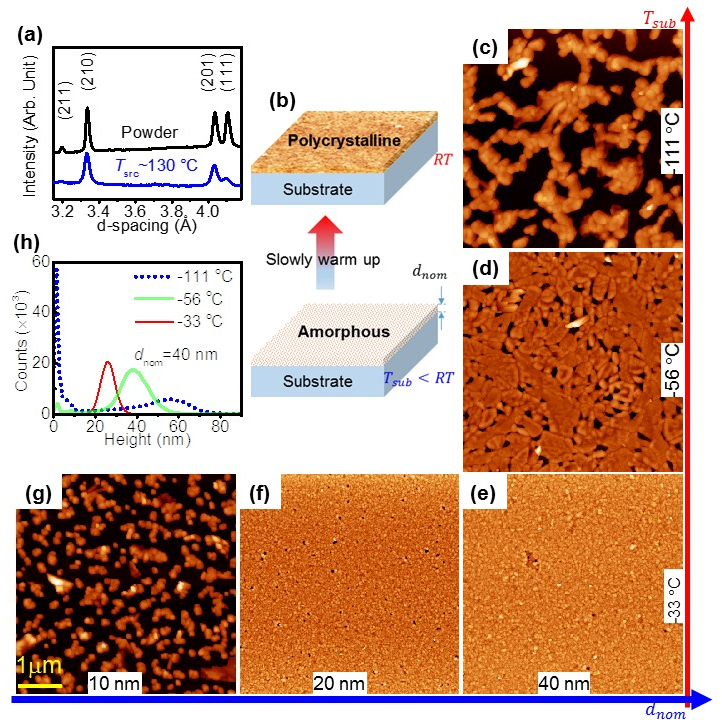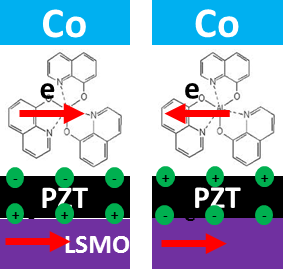Electric-field assisted nucleation processes of croconic acid films
 Growth of organic thin films using physical vapor deposition typically follows a three-dimensional mode, resulting in a rough surface, which undermines their application potential. We found that the electric field decreases the sublimation temperature, increases the wetting angle, and decreases the surface diffusion barrier. These results provide important insight into the growth of molecular crystal films under electric fields and pave the way to fabricating films with better surface characteristics for molecular ferroelectric films. See more details: CrystEngComm, 2019, 21, 7460–7467. Growth of organic thin films using physical vapor deposition typically follows a three-dimensional mode, resulting in a rough surface, which undermines their application potential. We found that the electric field decreases the sublimation temperature, increases the wetting angle, and decreases the surface diffusion barrier. These results provide important insight into the growth of molecular crystal films under electric fields and pave the way to fabricating films with better surface characteristics for molecular ferroelectric films. See more details: CrystEngComm, 2019, 21, 7460–7467. |
Recent progresses of ferroelectric control of magnetoresistance in organic spin valves
 Ferroelectricity has been introduced to organic spin valves to manipulate the magneto transport, where the spin transport through the ferromagnet/organic spacer interfaces (spinterface) are under intensive study. The ferroelectric materials in the organic spin valves provide a knob to vary the interfacial energy alignment and the interfacial crystal structures, both are critical for the spin transport. In this review, we introduce the recent efforts of controlling magnetoresistance of organic spin valves using ferroelectricity, where the ferroelectric material is either inserted as an interfacial layer or used as a spacer material. See more details: J Materiomics 4, 1-12 (2018). Ferroelectricity has been introduced to organic spin valves to manipulate the magneto transport, where the spin transport through the ferromagnet/organic spacer interfaces (spinterface) are under intensive study. The ferroelectric materials in the organic spin valves provide a knob to vary the interfacial energy alignment and the interfacial crystal structures, both are critical for the spin transport. In this review, we introduce the recent efforts of controlling magnetoresistance of organic spin valves using ferroelectricity, where the ferroelectric material is either inserted as an interfacial layer or used as a spacer material. See more details: J Materiomics 4, 1-12 (2018). |
Room temperature ferroelectricity in continuous croconic acid thin films
 Croconic acid is an organic ferroelectric material above room temperature. However, the fabrication of thin films has been difficult. Using physical vapor deposition at high vacuum, we demonstrated the growth of continuous croconic acid films of nm thickness, which retain room temperature ferroelectricity at the same time. See more details: Applied Physics Letters 109, 102902 (2016), arXiv Croconic acid is an organic ferroelectric material above room temperature. However, the fabrication of thin films has been difficult. Using physical vapor deposition at high vacuum, we demonstrated the growth of continuous croconic acid films of nm thickness, which retain room temperature ferroelectricity at the same time. See more details: Applied Physics Letters 109, 102902 (2016), arXiv |
Organic spin valve that's tunable by an electric field
 Organic spin valves are like switches that can be turned on and off using a magnetic field. In our recent study, we demonstrated that it can also be tuned using an electric field, by inserting an ferroelectric layer in the structure. See more details:Nat. Comm. 5, 4396 (2014), arXiv. Organic spin valves are like switches that can be turned on and off using a magnetic field. In our recent study, we demonstrated that it can also be tuned using an electric field, by inserting an ferroelectric layer in the structure. See more details:Nat. Comm. 5, 4396 (2014), arXiv. |
 Growth of organic thin films using physical vapor deposition typically follows a three-dimensional mode, resulting in a rough surface, which undermines their application potential. We found that the electric field decreases the sublimation temperature, increases the wetting angle, and decreases the surface diffusion barrier. These results provide important insight into the growth of molecular crystal films under electric fields and pave the way to fabricating films with better surface characteristics for molecular ferroelectric films. See more details: CrystEngComm, 2019, 21, 7460–7467.
Growth of organic thin films using physical vapor deposition typically follows a three-dimensional mode, resulting in a rough surface, which undermines their application potential. We found that the electric field decreases the sublimation temperature, increases the wetting angle, and decreases the surface diffusion barrier. These results provide important insight into the growth of molecular crystal films under electric fields and pave the way to fabricating films with better surface characteristics for molecular ferroelectric films. See more details: CrystEngComm, 2019, 21, 7460–7467.  Ferroelectricity has been introduced to organic spin valves to manipulate the magneto transport, where the spin transport through the ferromagnet/organic spacer interfaces (spinterface) are under intensive study. The ferroelectric materials in the organic spin valves provide a knob to vary the interfacial energy alignment and the interfacial crystal structures, both are critical for the spin transport. In this review, we introduce the recent efforts of controlling magnetoresistance of organic spin valves using ferroelectricity, where the ferroelectric material is either inserted as an interfacial layer or used as a spacer material. See more details: J Materiomics 4, 1-12 (2018).
Ferroelectricity has been introduced to organic spin valves to manipulate the magneto transport, where the spin transport through the ferromagnet/organic spacer interfaces (spinterface) are under intensive study. The ferroelectric materials in the organic spin valves provide a knob to vary the interfacial energy alignment and the interfacial crystal structures, both are critical for the spin transport. In this review, we introduce the recent efforts of controlling magnetoresistance of organic spin valves using ferroelectricity, where the ferroelectric material is either inserted as an interfacial layer or used as a spacer material. See more details: J Materiomics 4, 1-12 (2018). Organic spin valves are like switches that can be turned on and off using a magnetic field. In our recent study, we demonstrated that it can also be tuned using an electric field, by inserting an ferroelectric layer in the structure. See more details:Nat. Comm. 5, 4396 (2014), arXiv.
Organic spin valves are like switches that can be turned on and off using a magnetic field. In our recent study, we demonstrated that it can also be tuned using an electric field, by inserting an ferroelectric layer in the structure. See more details:Nat. Comm. 5, 4396 (2014), arXiv.